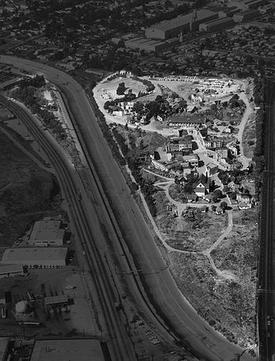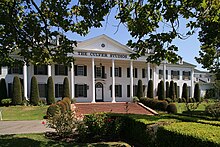
David O. Selznick was an American film producer, screenwriter and film studio executive who produced Gone with the Wind (1939) and Rebecca (1940), both of which earned him an Academy Award for Best Picture. He also won the Irving Thalberg Award at the 12th Academy Awards, Hollywood's top honor for a producer, in recognition of his shepherding Gone with the Wind through a long and troubled production and into a record-breaking blockbuster.

Culver City is a city in Los Angeles County, California, United States. As of the 2020 census, the population was 40,779.

Desilu Productions, Inc. was an American television production company founded and co-owned by husband and wife Desi Arnaz and Lucille Ball. The company is best known for shows such as I Love Lucy, The Lucy Show, Mannix, The Untouchables, Mission: Impossible and Star Trek. Until 1962, Desilu was the second-largest independent television production company in the United States, behind MCA's Revue Studios, until MCA bought Universal Pictures and Desilu became and remained the number-one independent production company, until Ball sold it to Gulf and Western Industries in 1968.

The Hollywood Heritage Museum, also known as the "Hollywood Studio Museum," is located on Highland Ave. in Hollywood, California, United States.

Radford Studio Center, alternatively CBS Studio Center, is a television and film studio located in the Studio City district in the San Fernando Valley of Los Angeles, California, United States. The lot has 18 sound stages from 7,000 to 25,000 square feet, 220,000 square feet (20,000 m2) of office space, and 223 dressing rooms. The triangular site is bisected by the Los Angeles River. In 2021, ViacomCBS sold Studio Center to real estate investment companies Hackman Capital Partners and Square Mile Capital Management.

Selznick International Pictures was a Hollywood motion picture studio created by David O. Selznick in 1935, and dissolved in 1943. In its short existence the independent studio produced two films that received the Academy Award for Best Picture—Gone with the Wind (1939) and Rebecca (1940)—and three that were nominated, A Star Is Born (1937), Since You Went Away (1944) and Spellbound (1945).

The Sony Pictures Studios is an American television and film studio complex located in Culver City, California at 10202 West Washington Boulevard and bounded by Culver Boulevard (south), Washington Boulevard (north), Overland Avenue (west) and Madison Avenue (east). Founded in 1912, the facility is currently owned by Sony Pictures and houses the division's film studios, such as Columbia Pictures, TriStar Pictures, and Screen Gems. The complex was the original studios of Metro-Goldwyn-Mayer from 1924 to 1986 and Lorimar-Telepictures from 1986 to 1988.

RKO Forty Acres was a film studio backlot in the United States, owned by RKO Pictures, located in Culver City, California. Best known as Forty Acres and "the back forty," it was also called "Desilu Culver," the "RKO backlot," and "Pathé 40 Acre Ranch," depending on which studio owned the property at the time. For nearly 50 years it was known for its outdoor full-scale sets, such as Western Street, Atlanta Street, and Main Street and was used in many films and television series.
Edendale is a historical name for a district in Los Angeles, California, northwest of Downtown Los Angeles, in what is known today as Echo Park, Los Feliz and Silver Lake. In the opening decades of the 20th century, in the era of silent movies, Edendale was known as the home of most major movie studios on the West Coast. Among its many claims, it was home to the Keystone Cops, and the site of many movie firsts, including Charlie Chaplin's first movie, the first feature-length comedy, and the first pie-in-the-face. The Edendale movie studios were mostly concentrated in a four-block stretch of Allesandro Street, between Berkeley Avenue and Duane Street. Allesandro Street was later renamed Glendale Boulevard.
Vancouver Film Studios is a film production facility located in Vancouver, British Columbia, Canada, and is operated by the McLean Group of Companies. It consists of 12 purpose-built sound stages ranging in size from 12,500 to 21,000 square feet, eight production offices, and other support spaces. VFS in 2006 was the recipient of a BC Export Award in the New Media and Entertainment section, and was recognized as one of the top 21 exporters in British Columbia. It was founded in 1999.

Sunset Gower Studios is a 14-acre (57,000 m2) television and movie studio at the corner of Sunset Boulevard and North Gower Street in the Hollywood neighborhood of Los Angeles, California, United States. Established in 1912, it continues today as Hollywood's largest independent studio and an active facility for television and film production on its twelve soundstages.

Pathé Exchange, commonly known as Pathé, was an American film production and distribution company, largely of Hollywood's silent era. Known for its trailblazing newsreel and wide array of shorts, it grew out of the American division of the major French studio Pathé Frères, which began distributing films in the United States in 1904. Ten years later, it produced the enormously successful The Perils of Pauline, a twenty-episode serial that came to define the genre. The American operation was incorporated as Pathé Exchange toward the end of 1914 and spun off as an independent entity in 1921; the Merrill Lynch investment firm acquired a controlling stake. The following year, it released Robert J. Flaherty's groundbreaking documentary Nanook of the North. Other notable feature releases included the controversial drama Sex (1920) and director/producer Cecil B. DeMille's box-office-topping biblical epic The King of Kings (1927/28). During much of the 1920s, Pathé distributed the shorts of comedy pioneers Hal Roach and Mack Sennett and innovative animator Paul Terry. For Roach and then his own production company, acclaimed comedian Harold Lloyd starred in many feature and short releases from Pathé and the closely linked Associated Exhibitors, including the 1925 smash hit The Freshman.
Pioneer Pictures, Inc. was a Hollywood motion picture company, most noted for its early commitment to making color films. Pioneer was initially affiliated with RKO Pictures, whose production facilities in Culver City, California were used by Pioneer, and who distributed Pioneer's films. Pioneer later merged with Selznick International Pictures.
A film studio is a major entertainment company that makes films. They may have their own privately owned studio facility or facilities; however, most firms in the entertainment industry have never owned their own studios, but have rented space from other companies. The day-to-day filming operations are generally handled by their production company subsidiary.

Thomas Harper Ince was an American silent era filmmaker and media proprietor. Ince was known as the "Father of the Western" and was responsible for making over 800 films.

The Warner Bros. Ranch is a movie ranch located at 411 North Hollywood Way in Burbank, California. Opened in the 1930s, it was used as the backdrop for films and television shows by Columbia Pictures and Warner Bros.
Producers Distributing Corporation (PDC) was a short-lived Hollywood film distribution company, organized in 1924 and dissolved in 1927. In its brief heyday, film director Cecil B. DeMille was its primary talent and owner of its Culver City–located production facility.

RKO Radio Pictures Inc., commonly known as RKO Pictures or simply RKO, was an American film production and distribution company, one of the "Big Five" film studios of Hollywood's Golden Age. The business was formed after the Keith-Albee-Orpheum theater chain and Joseph P. Kennedy's Film Booking Offices of America studio were brought together under the control of the Radio Corporation of America (RCA) in October 1928. RCA executive David Sarnoff engineered the merger to create a market for the company's sound-on-film technology, RCA Photophone, and in early 1929 production began under the RKO name. Two years later, another Kennedy concern, the Pathé studio, was folded into the operation. By the mid-1940s, RKO was controlled by investor Floyd Odlum.

Warner Bros. Studios, Burbank, formerly known as First National Studio (1926–1929), Warner Bros.-Seven Arts Studios (1967–1970) and The Burbank Studios (1972–1990), is a major filmmaking facility owned and run by Warner Bros. Entertainment Inc. in Burbank, California. First National Pictures built the 62-acre (25 ha) studio lot in 1926 as it expanded from a film distributor to film production.


















